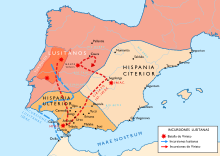| Lusitanian War | |||||||||
|---|---|---|---|---|---|---|---|---|---|
 | |||||||||
| |||||||||
| Belligerents | |||||||||
| Celtic tribes vassal to Rome (Cynetes, Turdetani...) |
Lusitanian tribes Other Celtic tribes (Vettones, Gallaeci...) | ||||||||
| Commanders and leaders | |||||||||
|
Servius Sulpicius Galba Gaius Vetilius Gaius Plancius Gaius Nigidius Fabius Aemilianus Fabius Servilianus Quintus Servilius Caepio Marcus Popillius Laenas |
Viriathus Tautalus Curius Apuleius Punicus Caesarus Caucenus | ||||||||
| Strength | |||||||||
| 10,000 which only 6,000 survived | 10,000–5,000 | ||||||||
| Casualties and losses | |||||||||
| More than 4,000 | 50–100 | ||||||||
The Lusitanian War, called Pyrinos Polemos ("the Fiery War") in Greek,[1] was a war of resistance fought by the Lusitanian tribes of Hispania Ulterior against the advancing legions of the Roman Republic from 155 to 139 BC. The Lusitanians revolted in 155 BC, and again in 146 BC and were pacified. In 154 BC, a long war in Hispania Citerior, known as the Numantine War, was begun by the Celtiberians. It lasted until 133 and is an important event in the integration of what would become Portugal into the Roman and Latin-speaking world.